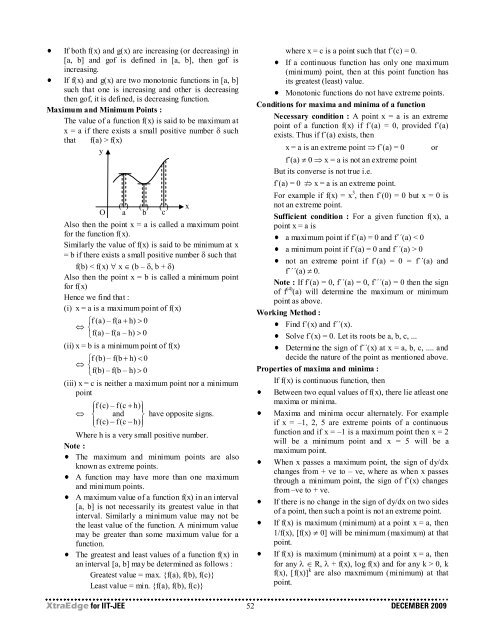You also want an ePaper? Increase the reach of your titles
YUMPU automatically turns print PDFs into web optimized ePapers that Google loves.
If both f(x) and g(x) are increasing (or decreasing) in<br />
[a, b] and gof is defined in [a, b], then gof is<br />
increasing.<br />
If f(x) and g(x) are two monotonic functions in [a, b]<br />
such that one is increasing and other is decreasing<br />
then gof, it is defined, is decreasing function.<br />
Maximum and Minimum <strong>Point</strong>s :<br />
The value of a function f(x) is said to be maximum at<br />
x = a if there exists a small positive number δ such<br />
that f(a) > f(x)<br />
y<br />
( ) ( ) ( ) x<br />
O a b c<br />
Also then the point x = a is called a maximum point<br />
for the function f(x).<br />
Similarly the value of f(x) is said to be minimum at x<br />
= b if there exists a small positive number δ such that<br />
f(b) < f(x) ∀ x ∈ (b – δ, b + δ)<br />
Also then the point x = b is called a minimum point<br />
for f(x)<br />
Hence we find that :<br />
(i) x = a is a maximum point of f(x)<br />
⇔ ⎨ ⎧ f (a) – f(a + h) > 0<br />
⎩ f(a) – f(a – h) > 0<br />
(ii) x = b is a minimum point of f(x)<br />
⇔ ⎨ ⎧ f (b) – f(b + h) < 0<br />
⎩ f(b) – f(b – h) > 0<br />
(iii) x = c is neither a maximum point nor a minimum<br />
point<br />
⎪⎧<br />
f (c) – f(c + h) ⎪⎫<br />
⇔ ⎨ and ⎬ have opposite signs.<br />
⎪⎩ f(c) − f(c − h) ⎪⎭<br />
Where h is a very small positive number.<br />
Note :<br />
The maximum and minimum points are also<br />
known as extreme points.<br />
A function may have more than one maximum<br />
and minimum points.<br />
A maximum value of a function f(x) in an interval<br />
[a, b] is not necessarily its greatest value in that<br />
interval. Similarly a minimum value may not be<br />
the least value of the function. A minimum value<br />
may be greater than some maximum value for a<br />
function.<br />
The greatest and least values of a function f(x) in<br />
an interval [a, b] may be determined as follows :<br />
Greatest value = max. {f(a), f(b), f(c)}<br />
Least value = min. {f(a), f(b), f(c)}<br />
where x = c is a point such that f´(c) = 0.<br />
If a continuous function has only one maximum<br />
(minimum) point, then at this point function has<br />
its greatest (least) value.<br />
Monotonic functions do not have extreme points.<br />
Conditions for maxima and minima of a function<br />
Necessary condition : A point x = a is an extreme<br />
point of a function f(x) if f´(a) = 0, provided f´(a)<br />
exists. Thus if f´(a) exists, then<br />
x = a is an extreme point ⇒ f´(a) = 0 or<br />
f´(a) ≠ 0 ⇒ x = a is not an extreme point<br />
But its converse is not true i.e.<br />
f´(a) = 0 /⇒ x = a is an extreme point.<br />
For example if f(x) = x 3 , then f´(0) = 0 but x = 0 is<br />
not an extreme point.<br />
Sufficient condition : For a given function f(x), a<br />
point x = a is<br />
a maximum point if f´(a) = 0 and f´´(a) < 0<br />
a minimum point if f´(a) = 0 and f´´(a) > 0<br />
not an extreme point if f´(a) = 0 = f´´(a) and<br />
f´´´(a) ≠ 0.<br />
Note : If f´(a) = 0, f´´(a) = 0, f´´´(a) = 0 then the sign<br />
of f (4) (a) will determine the maximum or minimum<br />
point as above.<br />
Working Method :<br />
Find f´(x) and f´´(x).<br />
Solve f´(x) = 0. Let its roots be a, b, c, ...<br />
Determine the sign of f´´(x) at x = a, b, c, .... and<br />
decide the nature of the point as mentioned above.<br />
Properties of maxima and minima :<br />
If f(x) is continuous function, then<br />
Between two equal values of f(x), there lie atleast one<br />
maxima or minima.<br />
Maxima and minima occur alternately. For example<br />
if x = –1, 2, 5 are extreme points of a continuous<br />
function and if x = –1 is a maximum point then x = 2<br />
will be a minimum point and x = 5 will be a<br />
maximum point.<br />
When x passes a maximum point, the sign of dy/dx<br />
changes from + ve to – ve, where as when x passes<br />
through a minimum point, the sign of f´(x) changes<br />
from –ve to + ve.<br />
If there is no change in the sign of dy/dx on two sides<br />
of a point, then such a point is not an extreme point.<br />
If f(x) is maximum (minimum) at a point x = a, then<br />
1/f(x), [f(x) ≠ 0] will be minimum (maximum) at that<br />
point.<br />
If f(x) is maximum (minimum) at a point x = a, then<br />
for any λ ∈ R, λ + f(x), log f(x) and for any k > 0, k<br />
f(x), [f(x)] k are also maxmimum (minimum) at that<br />
point.<br />
XtraEdge for <strong>IIT</strong>-<strong>JEE</strong> 52 DECEMBER 2009

















